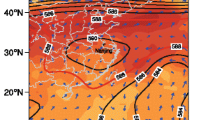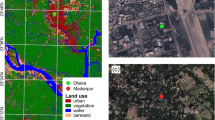Abstract
A strong urban heat island (UHI) appeared in a hot weather episode in Suzhou City during the period from 25 July to 1 August 2007. This paper analyzes the urban heat island characteristics of Suzhou City under this hot weather episode. Both meteorological station observations and MODIS satellite observations show a strong urban heat island in this area. The maximum UHI intensity in this hot weather episode is 2.2°C, which is much greater than the summer average of 1.0°C in this year and the 37-year (from 1970 to 2006) average of 0.35°C. The Weather Research and Forecasting (WRF) model simulation results demonstrate that the rapid urbanization processes in this area will enhance the UHI in intensity, horizontal distribution, and vertical extension. The UHI spatial distribution expands as the urban size increases. The vertical extension of UHI in the afternoon increases about 50 m higher under the year 2006 urban land cover than that under the 1986 urban land cover. The conversion from rural land use to urban land type also strengthens the local lake-land breeze circulations in this area and modifies the vertical wind speed field.
Similar content being viewed by others
References
Changnon, S. A., 1992: Inadvertent weather-modification in urban areas: Lessons for global climate change. Bull. Amer. Meteor. Soc., 73, 619–627.
Changnon, S. A., K. E. Kunkel, and B. C. Reinke, 1996: Impacts and responses to the 1995 heat wave: A call to action. Bull. Amer. Meteor. Soc., 77, 1497–1506.
Childs, P. P., and S. Raman, 2005: Observations and numerical simulations of urban heat island and sea breeze circulations over New York City. Pure Appl. Geophys., 162, 1955–1980.
Chen, L., W. Zhu, X. Zhou, and Z. Zhou, 2003: Characteristics of the heat island effect in Shanghai and its possible mechanism. Adv. Atmos. Sci., 20, 991–1001.
Comrie, A. C., 2000: Mapping a wind-modified urban heat island in Tucson, Arizona (with comments on integrating research and undergraduate learning). Bull. Amer. Meteor. Soc., 81, 2417–2431.
Ebi, K. L., T. J. Teisberg, L. S. Kalkstein, L. Robinson, and R. F. Weiher, 2004: Heat watch/warning systems save lives—Estimated costs and benefits for Philadelphia 1995–98. Bull. Amer. Meteor. Soci., 85, 1067–1073.
Fast, J. D., J. C. Torcolini, and R. Redman, 2005: Pseudovertical temperature profiles and the urban heat island measured by a temperature datalogger network in Phoenix, Arizona. J. Appl. Meteor., 44, 3–13.
Freitas, E. D., C. M. Rozoff, W. R. Cotton, and P. L. S. Dias, 2007: Interactions of an urban heat island and sea-breeze circulations during winter over the metropolitan area of Sao Paulo, Brazil. Bound.-Layer Meteor., 122(1), 43–65.
Gaffin, S. R., and Coauthors, 2008: Variations in New York city’s urban heat island strength over time and space. Theor. Appl. Climatol., 94, 1–11.
Gao, Z., and L. Bian, 2004: Estimation of aerodynamic roughness length and displacement of an urban surface from single-level sonic anemometer data. Aust. Meteor. Mag., 54, 21–28.
Grimmond, C. S. B., 2006: Progress in measuring and observing the urban atmosphere. Theor. Appl. Climatol., 84, 3–22.
Ji, C. P., W. D. Liu, and C. Y. Xuan, 2006: Impact of urban growth on the heat island in Beijing. Chinese J. Geophys., 49(1), 69–77. (in Chinese)
Kidder, S. Q., and O. M. Essenwanger, 1995: The effect of clouds and wind on the difference in nocturnal cooling rates between urban and rural-areas. J. Appl. Meteor., 34, 2440–2448.
Lemonsu, A., S. Bastin, V. Masson, and P. Drobinski, 2006: Vertical structure of the urban boundary layer over Marseille under sea-breeze conditions. Bound.-Layer Meteor., 118(3), 477–501.
Lu, J., S. P. Arya, W. H. Snyder, and R. E. Lawson, 1997a: A laboratory study of the urban heat island in a calm and stably stratified environment. 1. Temperature field. J. Appl. Meteor., 36, 1377–1391.
Lu, J., S. P. Arya, W. H. Snyder, and R. E. Lawson, 1997b: A laboratory study of the urban heat island in a calm and stably stratified environment. 2. Velocity field. J. Appl. Meteor., 36, 1392–1402.
Martilli, A., 2007: Current research and future challenges in urban mesoscale modelling. International Journal of Climatology, 27, 1909–1918.
Martilli, A., A. Clappier, and M.W. Rotach, 2002: An urban surface exchange parameterisation for mesoscale models. Bound.-Layer Meteor., 104, 261–304.
Meehl, G. A., and C. Tebaldi, 2004: More intense, more frequent, and longer lasting heat waves in the 21st century. Science, 305, 994–997.
Meng, W., Y. Zhang, J. Li, W. Lin, G. Dai, and H. Li, 2010: Application of WRF/UCM in the simulation of a heat wave event and urban heat island around Guangzhou city. Journal of Tropical Meteorology, 26, 273–282. (in Chinese)
Menut, L., C. Flamant, and J. Pelon, 1999: Evidence of interaction between synoptic and local scales in the surface layer over the Paris area. Bound.-Layer Meteor., 93, 269–286.
Miao, S., P. Li., and X. Wang, 2009a: Building morphological characteristics and their effect on the wind in Beijing. Adv. Atmos. Sci., 26(6), 1115–1124, doi: 10.1007/s00376-009-7223-7.
Miao, S. G., F. Chen, A. L. Magaret, T. Mukul, Q. Li, and Y. Wang, 2009b: An observational and modeling study of characteristics of urban heat island and boundary layer structures in Beijing. J. Appl. Meteor. Climatol., 48(3), 484–501.
Oke, T. R., R. A. Spronken-Smith, E. Jauregui, and C. S. B. Grimmond, 1999: The energy balance of central Mexico City during the dry season. Atmos. Environ, 33, 3919–3930.
Rong, C., H. Liu, and Y. Zhu, 2009: The study of the urban heat island and its influence factors in Suzhou City. Scientia Meteorologica Sinica, 29(1), 84–87.
Roth, M., and T. R. Oke, 1995: Relative efficiencies of turbulent transfer of heat, mass, and momentum over a patchy urban surface. J. Atmos. Sci., 52, 1863–1874.
Semenza, J. C., 1996: Deaths in the Chicago heat wave. New England Journal of Medicine, 335, 1848–1849.
Souch, C., and S. Grimmond, 2006: Applied climatology: Urban climate. Progr. Phys. Geogr., 30, 270–279.
Tan, J., Y. Zheng, G. Pen, S. Gu, and J. Shi, 2008: Effect of urban heat island on heat waves in summer of Shanghai. Plateau Meteorology, 27, 144–149. (in Chinese)
Tang, Y., and M. Miao, 1998: Numerical studies on urban heat island associated with urbanization in Yangtze Delta region. Adv. Atmos. Sci., 15(3), 393–403.
Trusilova, K., M. Jung, G. Churkina, U. Karstens, M. Heimann, and M. Claussen, 2008: Urbanization impacts on the climate in Europe: Numerical experiments by the PSU-NCAR Mesoscale Model (MM5). J. Appl. Meteor. Climatol., 47(5), 1442–1455.
Unger, J., Z. Sumeghy, A. Gulyas, Z. Bottyan, and L. Mucsi, 2001: Land-use and meteorological aspects of the urban heat island. Meteorol. Appl., 8, 189–194.
Wang, W. G., 2009: The influence of thermally-induced mesoscale circulations on turbulence statistics over an idealized urban area under a zero background wind. Bound. Layer Meteor., 131(3), 403–423.
Xu, Y., S. Liu, F. Hu, N. Ma, Y. Wang, Y. Shi, and H. Jia, 2009: Influence of Beijing urbanization on the characteristics of atmospheric boundary layer. Chinese J. Atmos. Sci., 33(4), 859–867. (in Chinese)
Zhang, J., W. Dong, L. Wu, J. Wei, P. Chen, and D. Lee, 2005: Impact of land use changes on surface warming in China. Adv. Atmos. Sci., 22, 343–348.
Zhang, N., W. Jiang, Z. Gao, F. Hu, and Z. Peng, 2009: Determination of urban surface aerodynamic characteristics using Marquardt method. Wind and Structures, 12(3), 281–283.
Zhang, N., Z. Gao, X. Wang, and Y. Chen, 2010: Modeling the impact of urbanization on the local and regional climate in Yangtze River Delta, China. Theor. Appl. Climatol., 102, 331–342.
Zhu, Y., and L. Zhu, 2009: An analysis on summer urban heat island in Suzhou using satellite data. Scientia Meteorologica Sinica, 29(1), 77–83.
Author information
Authors and Affiliations
Corresponding author
Rights and permissions
About this article
Cite this article
Zhang, N., Zhu, L. & Zhu, Y. Urban heat island and boundary layer structures under hot weather synoptic conditions: A case study of Suzhou City, China. Adv. Atmos. Sci. 28, 855–865 (2011). https://doi.org/10.1007/s00376-010-0040-1
Received:
Revised:
Published:
Issue Date:
DOI: https://doi.org/10.1007/s00376-010-0040-1




